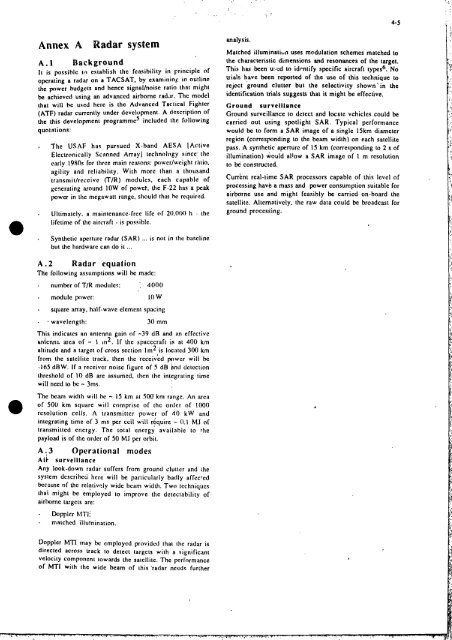0 - FTP Directory Listing - Nato
0 - FTP Directory Listing - Nato
0 - FTP Directory Listing - Nato
Create successful ePaper yourself
Turn your PDF publications into a flip-book with our unique Google optimized e-Paper software.
a<br />
0<br />
Annex A Radar system<br />
A. I Background<br />
It is possible to establish the feasibility in principle of<br />
opcrating a radar on a TACSAT. by examining in outline<br />
the pwcr budgets and hence signal/noisc ratio that might<br />
be achieved using an advanced airborne radJr. The model<br />
that will Dc uscd here is the Advanced Tactical Fighter<br />
(ATF) radar currently under development. A tlcscription of<br />
the this development programme5 included thc following<br />
quotations:<br />
- The USAF has pursued X-band AESA [Active<br />
Electronically Scanned AnayJ technology since, the<br />
early 1980s for three main rciuons: pciwcrlwcight rlitio.<br />
agility and rcliahility. With more than a thousand<br />
transmitlrcceive (T/R) modules. each capable of<br />
generating around IOW of powct, Ihc F.22 has a peak<br />
pwcr in the megawatt range. should that hc rcquircd.<br />
-<br />
Ultimately. a maintenance-free life of 20.0(N h . the<br />
lifetime of the airaaft - is possible.<br />
Synthetic apcrtiire radar (SAR) ... is not in ttic baseline<br />
but he hardware can do it ...<br />
A.2 Radar equation<br />
The following assumptions will be made:<br />
- number of T/K modules: , 4000<br />
* module plwcr: IOW<br />
- square anay. half-wave clement spacing<br />
- . wavelength: 30 nini<br />
Th,is indicatcs nn antenna gain of -39 dR and an cffcclivc<br />
anicnnr area of - 1 In2. If \he spacecraft is at 400 km<br />
altitude and a target of cross section Im2,is located 300 km<br />
from the satellite track. then the received power will bc<br />
-165 dRW. If a receiver noise figure of S dR bntl dctcction<br />
threshold of 10 dB arc assumed. then the integrating time<br />
will nwd to be - 3ms.<br />
The bcam width will hc - IS km at SW km range. An area<br />
of SO0 km square will cornprise of the ortlcr of 1000<br />
resolution cells. A transmitter power of 40 kW and<br />
integrating time of 3 ms pcr cell will r6quire - 0.1 MJ of<br />
transmitted energy. The total energy available ' to the<br />
payload is of the order of 50 MJ pcr orbit.<br />
A ;3 Operational modes<br />
AI; surveillance<br />
Any look-down radar suffers from ground clutter and the<br />
system dcscribcci here will be particularly badly affcc>cd<br />
bccsuse of the relfltivcly widc beam widh. Two techniques<br />
thai might be employed to improve the dctcclability of<br />
airborne targets are:<br />
- DopplCr hlTli<br />
- mntched illutnination.<br />
Doppler MTI may bc employed provided that thc radar is<br />
directed across track to detect targets with a significant<br />
velocity component towards the satellite. The pcrfnrmance<br />
of MTI with the widc beam of this 'radar needs further<br />
analysis.<br />
Matched illurninatibn uses modulation schemes matched to<br />
the characteristic dimensions and resonances of the target.<br />
This has been u:.cd to idrntify specific aircraft typcs6. No<br />
trials have been reported of the use of this technique to<br />
reject ground clutter but the selectivity shown'in he<br />
identification trials suggests hat it might be effective.<br />
Ground su rvelllnnce<br />
Ground surveillance to detect and locate vehicles could be<br />
carried out using spotlight SAR. Typical performance<br />
would be to form a SAR image of a single 15km diameter<br />
region (corresponding to the beam width) on each satellite<br />
pass. A synthetic apcrturc of 15 km (corresponding to 2 s of<br />
illumination) would allow a SAR image of I m resolution<br />
to be constructed.<br />
Current real-time SAR processors capable of this level of<br />
processing have a mass and power consumption suitable foi<br />
airborne use and might feasibly be carried on-board the<br />
satellite. Alternatively. the raw data could be broadcast for<br />
ground processing.<br />
,<br />
4-5<br />
:. $1<br />
*<br />
: I

















